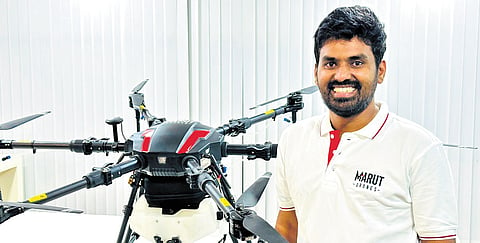

HYDERABAD: The ceasefire announcement between India and Pakistan may have eased immediate tensions, but it also highlighted the changing face of modern warfare. For residents near conflict zones, the brief period of hostilities left behind images of a high-tech battleground, where waves of drones lit up the night sky and were intercepted by Indian defence systems.
Once associated with everyday tasks like deliveries and event filming, drones have now taken centre stage in combat. Their role in the India-Pakistan conflict marks the first instance of widespread drone deployment by two nuclear-armed neighbours, adding complexity to an already volatile region.
Prem Kumar Vislawath, CEO and co-founder of Marut Drones, told TNIE: “Drones have reshaped modern warfare. They deliver real-time intelligence, enable precision strikes, and enhance situational awareness — all while minimising risk to personnel.” He pointed out that drones are used not just for surveillance or attack, but also to mislead enemy defences. “They’re used as decoys, suppress air defences, and can trigger radar emissions targeted by loitering munitions or anti-radiation missiles.”
Besta Prem Sai, CEO of Vecros, believes drones are moving beyond remote-controlled tools. “We envision drones that don’t just follow instructions, but take on dangerous tasks and freeing humans for strategic roles,” he said. Vectros’ autonomous drone, ATHERA, uses spatial AI and eight cameras to navigate complex terrains and make independent decisions, even when GPS or radio signals are jammed.
India’s drone capabilities have evolved rapidly. From early surveillance models, India now has systems like the loitering munition HAROP, capable of hovering, streaming live video, assessing targets and aborting missions mid-air. “That kind of flexibility isn’t possible with traditional precision weapons,” said Prem Kumar. He added that India is also investing in swarm drones — systems that operate in coordinated groups to overwhelm enemy defences.
Vecros is focusing on drones with vision-based navigation, using SLAM (simultaneous localisation and mapping) to function in environments where GPS is blocked. “We use anti-spoofing and anti-jamming features, real-time obstacle detection, and our own operating system, JETPIX, to support independent decision-making,” said Prem Sai. “It’s about giving drones the confidence to act, while ensuring mission-level oversight remains human.”
Both founders agree that future conflicts will be shaped by autonomy, AI, and real-time data. “Wars won’t be won by manpower anymore,” said Prem Kumar. “They’ll be shaped by drones acting as intelligent teammates.” Prem Sai added, “We’re moving toward full Level 5 autonomy — where drones can receive a mission goal and execute it independently, with ethical oversight.”
India’s defence ecosystem is adapting to these changes. With restrictions on foreign drone imports and policies supporting domestic innovation under Atmanirbhar Bharat, the sector is projected to grow to `30,000 crore by 2030. Startups like Marut and Vecros, supported by government initiatives and incubators, are playing a key role.
“India isn’t just catching up — we’re building globally competitive systems,” said Prem Kumar. Prem Sai concluded, “Our mission is to build drones that not only survive but excel in the most challenging environments — empowering armed forces with true autonomy and intelligence.”